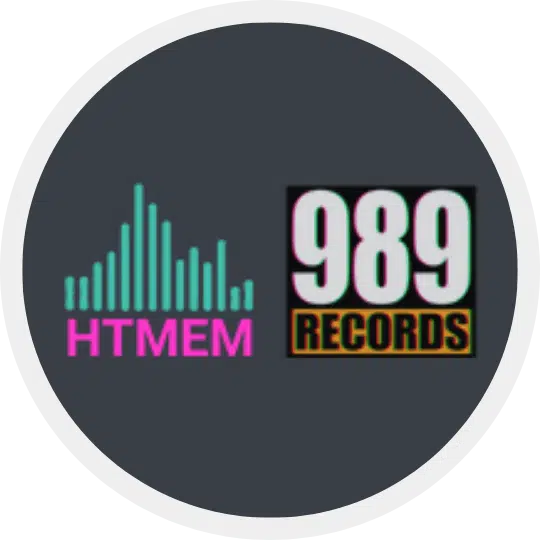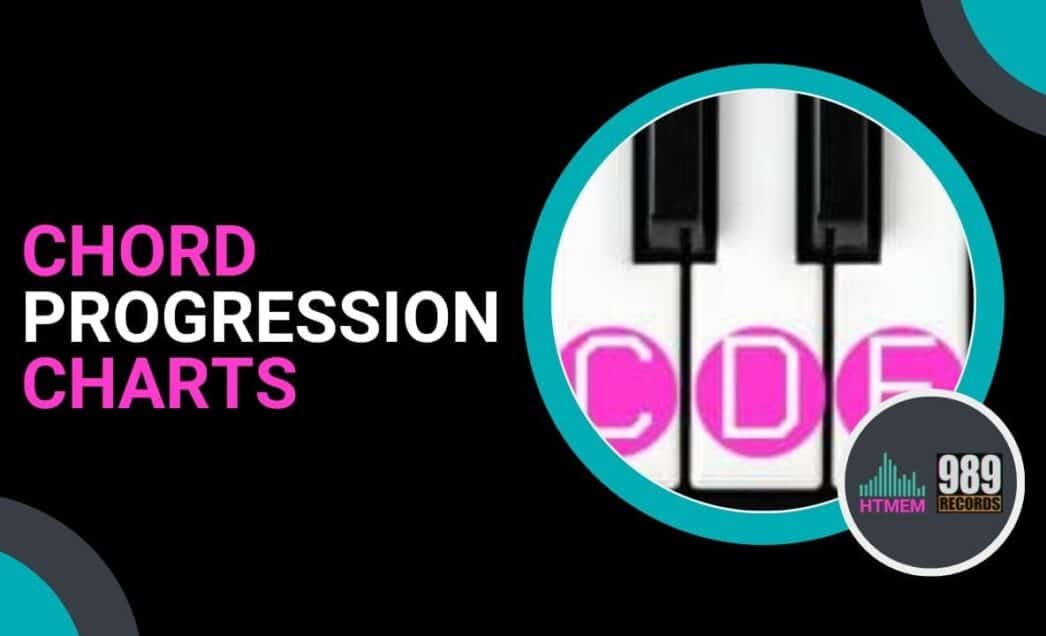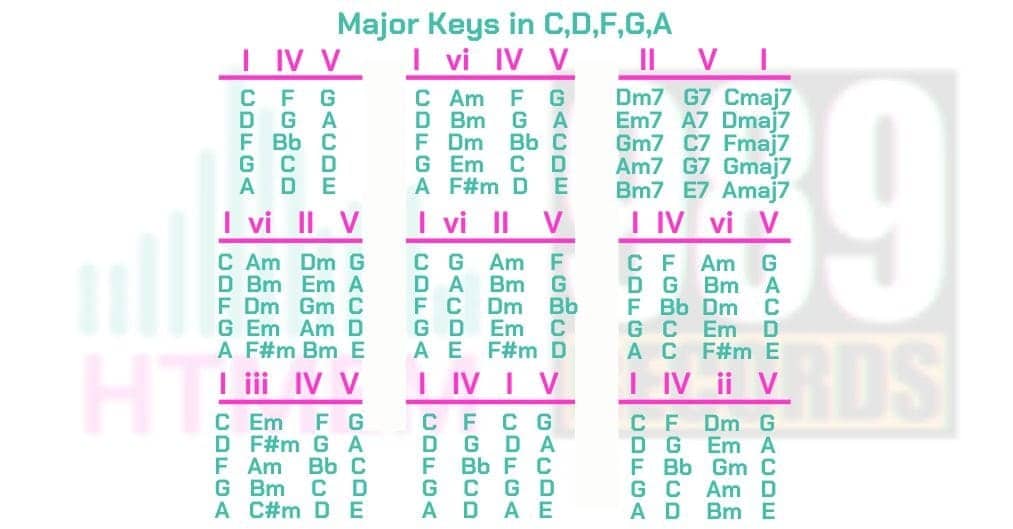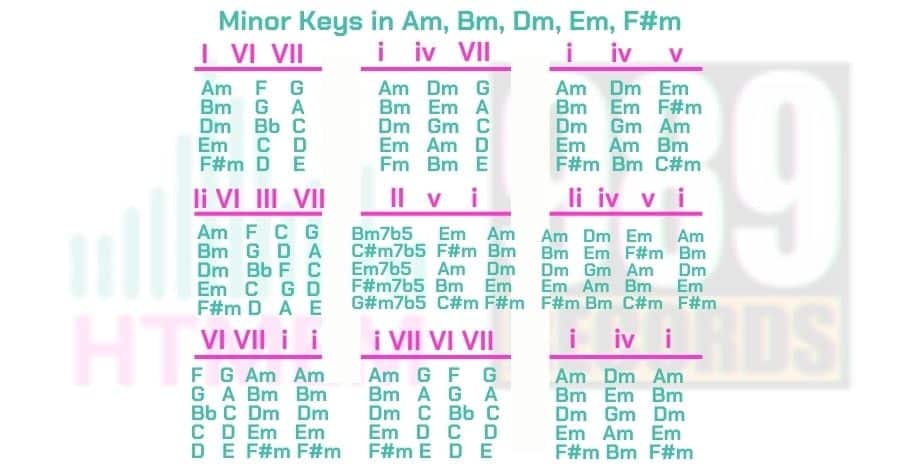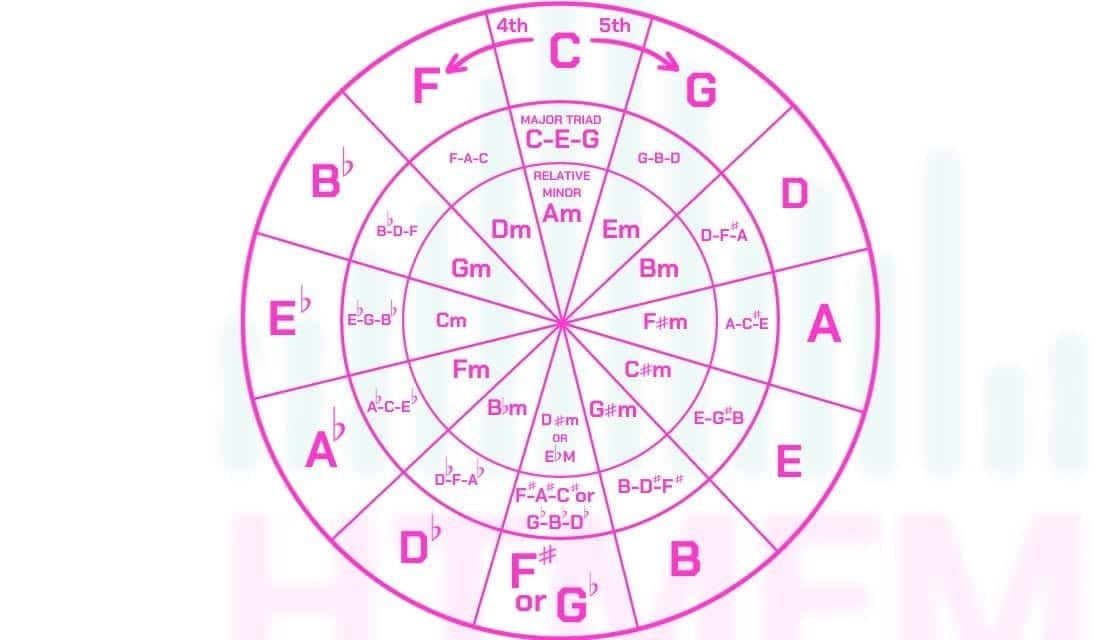“The beautiful thing about learning is that no one can take it away from you.” B.B. King:
Welcome to The HTMEM Blog.
Are you ready to discover the power of emotions in your music through chord progressions?
In this article, we will discover the world of chord progressions together.
To fuel your musical journey, you will find here a curated collection of our favorite charts—ready for you to start using and elevating your music today.
Creating chord progressions can be a daunting task.
Where do you begin? What comes next?
Should you stick to three chords or go for something more complex?
These simple yet invaluable tools will help you choose the right chords for your song and guide you in arranging them to create music that touches the deepest emotions.
But if you’re looking for a simple yet powerful method to compose music, Cubase’s Chord Pads and Chord Tracks are indispensable tools.
They empower you to effortlessly create captivating chord progressions, making music composition a breeze.
Learn How to Use Cubase Now
Table of Contents
Benefits of Utilizing Chord Progressions Charts
What is a Chord?
What Are Chord Progressions?
Chord Fundamentals: the Key and the Scale
Creating a Chord From a Key
How to Read a Chord Progression Charts
– Determine the Key
– Major or Minor Chords?
– Discover the Notes within the Scale
– Why Are We Using CMaj and Amin?
– How to Find Accidentals
The Roman Numeral System
Common Chord Progressions
– Major Chord Progressions
– Minor Chord Progressions
Note About the Circle of Fifths
Conclusions
Benefits of Utilizing Chord Progressions Charts
Chord progression charts are visual representations of the chords that are typically used in a certain key.
It can be a helpful tool for musicians, songwriters, and producers as it provides a quick and easy reference guide to create chord progressions in different keys.
Here are some benefits of utilizing a chord progression chart:
1. Saves Time and Effort: With a chord progression chart, you don’t have to spend time figuring out which chords go together in a particular key. It provides you with all the information you need in one place, saving you both time and effort.
2) Expands Your Musical Options: With a chord progression chart, you can explore new keys and expand your musical options. No longer limited to familiar keys, you can experiment with different chords and create unique progressions, enhancing creativity and depth in your compositions.
3) Improves Songwriting: A chord progression chart is a valuable tool for songwriters. It helps them quickly find compatible chord combinations as a foundation for their songs, saving time and improving quality. With it, they can easily create catchy and harmonious melodies to captivate their audience.
Looking to Save Even More Time?
Discover the power of Cubase and elevate your music production with the innovative Chord Pad Editor.
What is a Chord?
Talking about music theory, a chord is a group of three or more notes played simultaneously, creating a specific sound and feeling. If you want to write music, chords are essential in music as they provide the harmony and structure of a song.
This is a single D Note:
This is a D Major Chord chord using the same D note as the Root Key
And this is the D Major Chord Triad D-F#-A
What Are Chord Progressions?
Chord progressions are a sequence of chords played in a specific order to create a harmonic structure for your music.
These sequences can have a big impact on the overall mood and emotion of your song, making them an important aspect of music composition.
They are like building blocks that form the foundation of your melody and allow you to add layers and depth to your music. And in some cases, great songs are made only by a few chords.
Chord Progression Example A Min9 – Fmaj7/9 – Emin7 – Dmin7 – E7
Chord Fundamentals: the Key and the Scale
Before we dive into chord progressions, it’s important to understand two concepts: the key and the scale.
The Key determines what Set of Notes will be used in your music.
While the Scale is a Specific Arrangement of those notes.
There are 12 keys in Western music – one for each note including sharps and flats (# and b).
Each key has its unique sound and mood, making it essential to choose the right key for your intended emotion.
Within each key, there are commonly used scales that determine which notes can be played to create harmonious melodies.
The easiest key to play on a keyboard is C Major, consisting of all the white keys, with C as its Root Note.
For instance, the C Major Scale comprises seven notes: C, D, E, F, G, A, and B.
Here we have the Set of Notes for the C Major Scale
Creating a Chord From a Key
Let’s continue with our example of the C Major key.
The most common and basic type of chord is the Triad, which consists of 3 Notes.
To form a triad in the C Major key, you would typically start with the Root Note C, skip one note (D), include the next E, skip another note F, and include the next G.
This gives us the notes C, E, and G which form a C Major Triad – your first chord from this key!
By understanding how to create chords from keys, you can manipulate your musical pieces to express varying emotions and tones.
Remember, practice makes perfect – spend time experimenting with different keys and chords to unlock musical possibilities from a Key.
Learn How to Use Cubase Now
How to Read a Chord Progression Charts
Let’s dive right into decoding these musical treasures.
Understanding chord progression charts is a breeze with just 2 simple steps.
Determine the Key
The first step is to determine the key of the song.
Here are two simple methods to find your key very easily.
Method One: Try humming along to the song; it may seem simple, but it actually works. Stay calm and let the music guide you. Your body can guide you to the right note. Once there, play on your keyboard until you discover the key that complements your voice.
Method Two: Utilize software to instantly identify the key. Numerous plugins are available that can analyze the music piece and accurately determine the key. Check for Example the Antares Auto-Key.
Now, let’s say for example we found that the key of the song is F#.
Major or Minor Chords?
The next step is to determine whether a song is on a Minor or Major Scale.
To do that, listen back to the song and pay attention to its mood.
If the song feels upbeat or joyful, chances are it’s on a major scale.
Conversely, if the mood is melancholic or somber, the song is likely on a minor scale.
For our example, let’s assume that our hypothetical song is in a Minor Scale.
Discover the Notes within the Scale
Determining the notes in a scale doesn’t have to involve recalling complex music theory concepts. The simplest approach is to begin with the fundamental C Major Scale and its corresponding A Minor Scale (which is also its Relative Minor).
Why Are We Using CMaj and Amin?
The reason is that these two scales above do not include any accidentals (# or b), allowing you to play them solely using the white keys on the keyboard. This unique characteristic makes them accessible and convenient for musicians.
Now, let’s understand something more.
We already know that the C Major scale comprises seven notes: C, D, E, F, G, A, and B.
Each Minor Scale can be easily achieved by shifting 3 keys to the left from the major scale root note (in our case C). In our case, it consists of the notes A, B, C, D, E, F, and G.
With that being said, let’s delve into the process of identifying accidentals for a given scale.
How to Find Accidentals
Now, let’s focus on the example mentioned earlier, where we identified the key we are currently working with as F#.
As shown below, to locate all the accidentals in a given scale, you can easily navigate to the Piano Roll in your Digital Audio Workstation (DAW) and create notes for C Major to A Major Scales that, we already know, consist of only white keys.
Going back to the Major or Minor Scale concept, if you determine that your music follows a Major Scale, simply select the notes from C to C and remove the rest.
On the other hand, for those whose music aligns with a Minor Scale, select the notes from A to A and discard the rest.
So, in our example, the root note is F# and the scale is a Minor Scale.
To quickly identify all the accidentals, you’ll need to select all the A to A notes (the minor keys sequence) and transpose them to the root note, which, in this case, is F#.
Feeling perplexed?
Take a moment to watch this concise video below.
Learn How to Use Cubase Now
And now… Congratulations!
You have successfully identified all the notes and accidentals for your scale, effortlessly!
The Roman Numeral System
When you find the key, chord progression charts use the Roman numeral system to show specific chords within that key. The Roman numerals are assigned to chords based on the order of their root notes.
For example, starting with the note C, the first chord in the key (the tonic chord) is the C Major Chord, represented by the Roman numeral I (C-E-G).
As we ascend the scale, we encounter the D Minor (II – D-F-A).
and the E Minor (III – E-G-B).
This pattern continues until we return to C, resulting in a list of 7 chords that reside within the key of C Major.
A chord progression chart provides a sequence of Roman numerals, such as I-IV-V, indicating the first, fourth, and fifth chords in a key.
For example, in C Major, these chords are C Major (I), F Major (IV), and G Major (V).
Alternatively, in G Minor, the same progression would be G Minor (I), C Minor (IV), and D Minor (V).
Got it?
Once you have a solid understanding of this system, you can finally utilize any chord progression chart to your needs.
Common Chord Progressions
Let’s now explore some chord progressions with HTMEM’s user-friendly charts.
These charts provide a list of commonly used chord sequences, denoted by Roman numerals, that can be immediately applied to any song. These tried and tested progressions have been featured in countless hit songs.
Major Chord Progressions
If you are new to using chord progression charts, I highly suggest starting here to create great chord progression.
These chord progression charts provide a list of commonly used sequences of chords, denoted by Roman numerals.
Minor Chord Progressions
Note About the Circle of Fifths
For those seeking popular chord progressions, the Circle of Fifths can be an additional and valuable tool to explore. If you’re interested in delving deeper into this topic, I recommend checking out this informative post here on the HTMEM blog. It provides additional insights and expands your understanding.
Conclusions
Chord progressions are an essential aspect of music theory and composition. They provide the foundation for creating melodies and harmonies that evoke emotion and capture the listener’s attention. Understanding common chord progression can help you as a musician to expand your repertoire, experiment with different styles, and create unique compositions.
Steinberg Cubase is equipped with a convenient Chord Progression Builder. If you’re looking for a smart method to compose music, have a look at this post: Cubase Chord Progression Builder | Create Your Music With Ease
Suggested Readings
The Ultimate Waves Plug Guide: Find the Perfect Plugin for Your Music Production
How to Copyright a Song
Making a Music: A Comprehensive Guide for Beginners
Now Practice and Enjoy!
